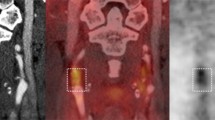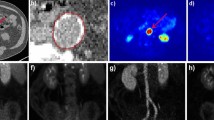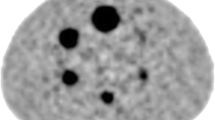Abstract
Purpose
The purpose of this study was to depict 18F-fluoro-2-deoxy-D-glucose (FDG) accumulation in atherosclerotic lesions of the thoracic and carotid arteries on CT and MR images by means of automatic co-registration software.
Methods
Fifteen hospitalised men suffering cerebral infarction or severe carotid stenosis requiring surgical treatment participated in this study. Automatic co-registration of neck MR images and FDG-PET images and of contrast-enhanced CT images and FDG-PET images was achieved with co-registration software. We calculated the count ratio, which was standardised to the blood pool count of the superior vena cava, for three arteries that branch from the aorta, i.e. the brachial artery, the left common carotid artery and the subclavian artery (n=15), for atherosclerotic plaques in the thoracic aorta (n=10) and for internal carotid arteries with and without plaque (n=13).
Results
FDG accumulated to a significantly higher level in the brachial artery, left common carotid artery and left subclavian artery at their sites of origin than in the superior vena cava (p=0.000, p=0.000 and p=0.002, respectively). Chest CT showed no atherosclerotic plaque at these sites. Furthermore, the average count ratio of thoracic aortic atherosclerotic plaques was not higher than that of the superior vena cava. The maximum count ratio of carotid atherosclerotic plaques was significantly higher than that of the superior vena cava but was not significantly different from that of the carotid artery without plaque.
Conclusion
The results of our study suggest that not all atherosclerotic plaques show high FDG accumulation. FDG-PET studies of plaques with the use of fused images can potentially provide detailed information about atherosclerosis.







Similar content being viewed by others
References
Falk E, Shah PK, Fuster V. Coronary plaque disruption. Circulation 1995;92:657–671
Ross R, Glomset J, Harker L. Response to injury and atherogenesis. Am J Pathol 1977;86:675–684
Ross R. Atherosclerosis—an inflammatory disease. N Engl J Med 1999;340:115–126
Rudd JH, Warburton EA, Fryer TD, Jones HA, Clark JC, Antoun N, et al. Imaging atherosclerotic plaque inflammation with [18F]-fluorodeoxyglucose positron emission tomography. Circulation 2002;105:2708–2711
Ogawa M, Ishino S, Mukai T, Asano D, Teramoto N, Watabe H, et al. 18F-FDG accumulation in atherosclerotic plaques: immunohistochemical and PET imaging study. J Nucl Med 2004;45:1245–1250
Toole JF. Cerebrovascular disorders: atherosclerosis. 3rd ed. New York: Raven Press; 1984
Fayad ZA, Fuster V, Fallon JT, Jayasundera T, Worthley SG, Helft G, et al. Noninvasive in vivo human coronary artery lumen and wall imaging using black-blood magnetic resonance imaging. Circulation 2000;102:506–510
Maes F, Collignon A, Vandermeulen D, Marchal G, Suetens P. Multimodality image registration by maximization of mutual information. IEEE Trans Med Imaging 1997;16:187–198
Woods RP, Grafton ST, Watson JQ, Sicotte NL, Mazziotta JC. Automated image registration: II. Intersubject validation of linear and nonlinear models. J Comput Assist Tomogr 1998;22:153–165
Ardekani BA, Braun M, Hutton BF, Kanno I, Iida H. A fully automatic multimodality image registration algorithm. J Comput Assist Tomogr 1995;19:615–623
Tatsumi M, Cohade C, Nakamoto Y, Wahl R. Fluorodeoxyglucose uptake in the aortic wall at PET/CT: possible finding for active atherosclerosis. Radiology 2003;229:831–837
Strauss HW, Dunphy M, Tokita N. Imaging the vulnerable plaque: a scintillating light at the end of the tunnel? J Nucl Med 2004;45:1106–1107
Willerson J, Ridker P. Inflammation as a cardiovascular risk factor. Circulation 2004;109 Suppl II:2–10
Schillinger M, Exner M, Mlekusch W, Sabeti S, Amighi J, Nikowitsch R, et al. Inflammation and carotid artery—risk for atherosclerosis study (ICARAS). Circulation 2005;111:2203–2209
Nakamoto Y, Tatsumi M, Hammoud D, Cohade C, Osman MM, Wahl R. Normal FDG distribution patterns in the head and neck: PET/CT evaluation. Radiology 2005;234:879–885
Acknowledgements
This work was supported in part by a Grant-In-Aid for Scientific Research provided by the Ministry of Education, Culture, Sports, Science and Technology of Japan and a grant from the Association of Nuclear Technology in Medicine in Japan. A special carotid artery coil was supplied by GE Medical Systems. We wish to thank Mika Sato, Risako Fujiwara and physicians in the stroke care unit for the patient arrangements, Akimitsu Sawaki for the mold arrangements and the entire radiology staff of the Research Institute for Brain and Blood Vessels–Akita.
Author information
Authors and Affiliations
Corresponding author
Rights and permissions
About this article
Cite this article
Okane, K., Ibaraki, M., Toyoshima, H. et al. 18F-FDG accumulation in atherosclerosis: use of CT and MR co-registration of thoracic and carotid arteries. Eur J Nucl Med Mol Imaging 33, 589–594 (2006). https://doi.org/10.1007/s00259-005-0005-2
Received:
Accepted:
Published:
Issue Date:
DOI: https://doi.org/10.1007/s00259-005-0005-2




